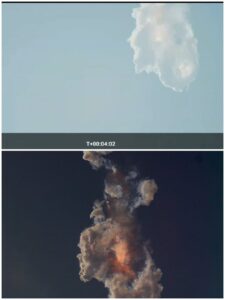Elon Musk’s SpaceX Starship rocket exploded on its maiden flight. The uncrewed test flight lifted off from Texas’ east coast, but the rocket tumbled uncontrollably after liftoff, triggering a Flight Termination System that caused it to explode.
The spacecraft, which is taller than the Saturn V rocket that took humans to the moon, is designed to carry up to 100 astronauts to colonize Mars and has a payload capacity of 150 tons. SpaceX engineers will collect and review data as they work towards the next flight, which is scheduled to take place in a couple of months. When its reliability is confirmed, people will be permitted to fly on the rocket.

It appeared that the booster and cruise vessel, the two rocket system components, were unable to properly separate after takeoff, possibly leading to the spacecraft’s failure. It was unclear right away if the rocket blew up on its own or if the Flight Termination System, a failsafe that obliterates the spaceship to keep it from deviating too far, was engaged.
The test flight’s goal was to gather data, regardless of whether the entire mission was accomplished, SpaceX had previously warned that the chances of success were minimal. Even after the rocket exploded, SpaceX workers cheered. “Congrats SpaceX Team on an exciting test launch of Starship! Learned a lot for next test launch in few months” Tweeted Elon Musk after the failed launch of Starlink Rocket.
Congrats @SpaceX team on an exciting test launch of Starship!
Learned a lot for next test launch in a few months. pic.twitter.com/gswdFut1dK
— Elon Musk (@elonmusk) April 20, 2023
SpaceX has a history of being willing to have test missions explode, in contrast to NASA, which tries to minimize risk. According to Musk, the private company gains from knowing what goes wrong. To launch its rockets, SpaceX constructed its own spaceport, known as Starbase, at Boca Chica, Texas, on the Gulf of Mexico. For upcoming tests, several other Starships are already in the work.


